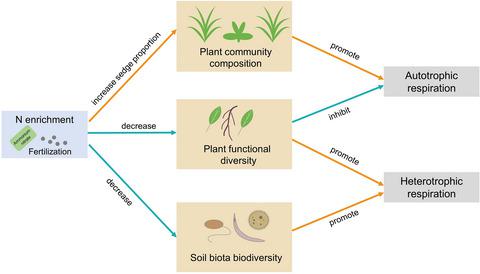当前位置:
X-MOL 学术
›
Funct. Ecol.
›
论文详情
Our official English website, www.x-mol.net, welcomes your
feedback! (Note: you will need to create a separate account there.)
Changes in above‐/below‐ground biodiversity and plant functional composition mediate soil respiration response to nitrogen input
Functional Ecology ( IF 4.6 ) Pub Date : 2021-03-02 , DOI: 10.1111/1365-2435.13783 Dianye Zhang 1, 2 , Yunfeng Peng 1 , Fei Li 1, 2 , Guibiao Yang 1, 2 , Jun Wang 1, 2 , Jianchun Yu 1, 2 , Guoying Zhou 3 , Yuanhe Yang 1, 2
更新日期:2021-05-07
Functional Ecology ( IF 4.6 ) Pub Date : 2021-03-02 , DOI: 10.1111/1365-2435.13783 Dianye Zhang 1, 2 , Yunfeng Peng 1 , Fei Li 1, 2 , Guibiao Yang 1, 2 , Jun Wang 1, 2 , Jianchun Yu 1, 2 , Guoying Zhou 3 , Yuanhe Yang 1, 2
Affiliation

|
- Biodiversity loss and changes in plant community composition induced by anthropogenic nitrogen (N) deposition exert profound effects on ecosystem functions. However, limited studies have considered the joint effects of plant community composition, plant species richness, plant functional diversity and soil biodiversity on the dynamics of soil autotrophic and heterotrophic respiration under extra N input.
- We addressed this issue by conducting a multilevel N‐manipulation experiment in a Tibetan alpine steppe. Based on soil respiration observations as well as biotic and abiotic measurements under this N addition experiment, we quantified the relative and interactive effects of above‐/below‐ground biodiversity, plant community composition and other explanatory variables (environmental factors, plant and microbial properties) on autotrophic and heterotrophic respiration.
- Our results showed that the effects of N enrichment via plant productivity, root amount, the proportion of sedge biomass and plant functional diversity explained 71% of the N‐induced variations in autotrophic respiration. With regard to heterotrophic respiration, the combination of N addition, soil pH, plant functional diversity and soil biota diversity accounted for 78% of its variations along the N addition gradient. Further analyses showed that above‐/below‐ground diversity loss and changes in plant community composition explained similar variation to that contributed by other factors in both autotrophic and heterotrophic respiration. The declined plant functional diversity and the increased proportion of sedge biomass promoted autotrophic respiration. Conversely, the loss of soil biodiversity together with the decreased plant functional diversity led to the decline of heterotrophic respiration along the experimental N gradient.
- Our results highlight that the indirect regulation of N input on ecosystem function through changes in plant community composition and above‐/below‐ground biodiversity loss should be considered for better understanding the responses of terrestrial ecosystems to atmospheric N deposition.











































 京公网安备 11010802027423号
京公网安备 11010802027423号